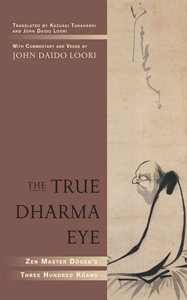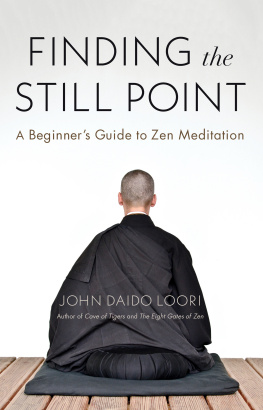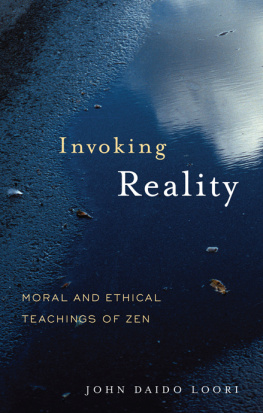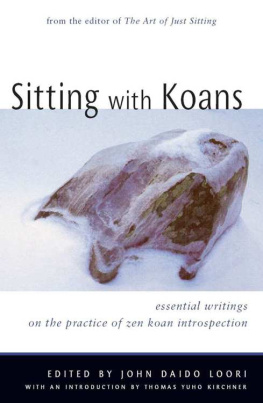C ONTENTS
E DITORS P REFACE
Come said the muse,
Sing me a song no poet has yet chanted,
Sing me the universal.
In this broad earth of ours,
Amid the measureless grossness and the slag,
Enclosed and safe within its central heart,
Nestles the seed of perfection.
By every life a share or more or less,
None born but it is born, conceald or unconceald the seed is.
Walt Whitman
I N THE COLD, DAMP SHELTERS of our primitive ancestors, lit only by the flickering of a campfire, at days end there was a time for recollection and stillness that would help to fuel the next days events. Since the beginning of human history, the still point has served as the birthplace of all our activity. Virtually every creature on this great earth practices the backward step of quieting down and entering this still point. Birds, beasts, bugs, and fish all seem to find time in their daily existence to relax and recreateto bring forth the flower from what Whitman called the seed of perfection.
For us humans, relaxation is much more elusive, and even though its benefits are widely known, they are rarely appreciated. In the field of science, studies have shown that when the body is relaxed and free of tension, and the mind is not grasping at thoughts, remarkable physiological and psychological transformations take place. During deep relaxation, a persons respiration, heart rate, blood pressure, and rate of metabolism all slow down to a stable resting place. Since 1924, researchers have been able to measure the electrical activity in the brain and have discovered that alpha waves are created when the brain activity is stabilized, as when a person is in a meditative state. Beta waves, on the other hand, are present when a person is engaged in physical or mental activity. Though all this is now common knowledge, particularly interesting and relevant to us are the residual effects of these waves. While monitoring meditators, scientists found that alpha waves produced in meditation often continue on when activity is engaged. The energy to perform the activity is there, but not the tension.
Meditation in a variety of forms has been present worldwide since ancient times. A central spiritual practice for many of the great mystics, meditation has been used for both physical and spiritual restoration and as a potent preparation for strenuous undertakings. The warrior takes a moment to center himself as he gets ready for battle, as does the athlete for competition, or the musician for a performance. Meditation, in one form or another, has been intrinsic to most of the great religions of the world. Some traditions may have developed it more than others, but its presence is widespread and undeniable.
In the Buddhist tradition, meditation has been a core element of practice since the time of Shakyamuni Buddha, two thousand five hundred years ago. Different schools of Buddhism may emphasize other forms of practice, but meditation remains instrumental in all of them for attaining enlightenment. In the Zen school, meditation is the sine qua non of Zen practice and realization. The Five Houses of the Zen School during the Tang Dynastys Golden Age of Zen all recognized zazen (meditation) as the heart of their practice. In fact, by definition, Zen Buddhism is meditation Buddhismthe word zen is a derivative of the Chinese word chan, which in turn is derived from the Sanskrit term dhyana, or meditation.
Shikantaza, or just sitting, is meditation without a goal. It is boundlessa process that is continually unfolding. Even students engaged in koan introspection, upon completion of their koan study, return to shikantaza during zazen. If you have ever wondered what kind of practice old Zen masters are doing, sitting so long and serenely year after year, the answer is: they are just sitting. The spiritual maturation resulting from this kind of practice is as subtle as it is profound. It shapes our spiritual character the way a river shapes the rocks it encounters on its journey to the sea. The resulting form has as much to do with the rock as with the action of the water, and the changes that take place are gradual and almost invisible. There is no definite way to chart this kind of activity. And so it is with sitting and the teachings that deal with it. We are left only with pointers, reminders that keep us moving in the right direction.
Given the importance placed on seated meditation in the Zen tradition, there is a surprisingly scant amount of written work addressing its practice. The volume of ancient and modern Zen literature is staggering, yet works that address meditation are few and far between. Is this because zazen is so simple and direct that all that can be said about it has already been said? Or is it that there is a profundity within the realm of zazen that is essentially ineffable? I am inclined to believe the latter. As Yasutani Roshi points out in his piece in this volume: Shikantaza should be taught personally and individually by the right teacher. Zen practitioners, as they progress beyond the beginning stages of zazen, encounter a unique landscape that reflects their own personality and individual life experiences. There is no map for this terrain, so an experienced guide is required. Shikantaza, the zazen of just sitting, is a continuous process of discovery that is aided by face-to-face encounters with an experienced teacher. Yet even teachers are limited in what they can do. Ultimately, the practitioners themselves must write their own rule book. They must go deep within themselves to find the foundations of zazen.
The Art of Just Sitting is an attempt to bring together some of the writings on shikantaza scattered over one thousand five hundred years of Zen history, from the time of its founder Bodhidharma in the fifth century down to the present time. A number of the pieces in this volume have been made previously available in English in a variety of publications, and, along with original material drawn from current teachings, they form a compilation of the best and most relevant of these widespread sources.
This book is inspiration for a sacred journey that, by its very nature, is wide open and limitless. But words can only take you so far. The journey is up to you. Like any practice that is worth doing, shikantaza demands commitment and personal discipline. Eventually, you may require the assistance of an experienced teacher. You will know when that time comes. Trust yourself and the process of zazen to guide you to the right teacher. If your sitting is strong and grounded, a teacher will appear and you will recognize him or her.
Like Whitmans muse, the ancient Zen masters beckon us to explore our own being, to discover the undiscovered, and in so doing, sing the song of the universal. We live at a time of great challenge and uncertainty, amid the measureless grossness and the slag. Yet, within each one of us lives a seed of perfection, the buddha nature. Every single one of us has it, by every life a share or more or less . And although some may realize the buddha nature and some may not, it is nevertheless present, waiting, as Whitmans poem suggests. It is my hope that the wisdom contained in these pages will awaken the spiritual journey for you, the reader, as it has for so many practitioners who have preceded us. Enclosed and safe within its central heart is your heart, your journey, your song. Please take it up, and realize the still point as it bursts into flower as this life itself.











